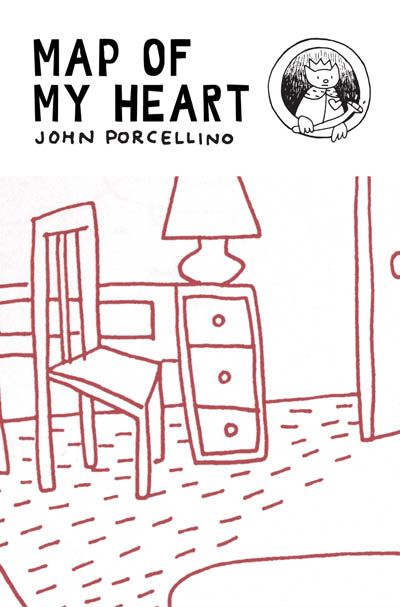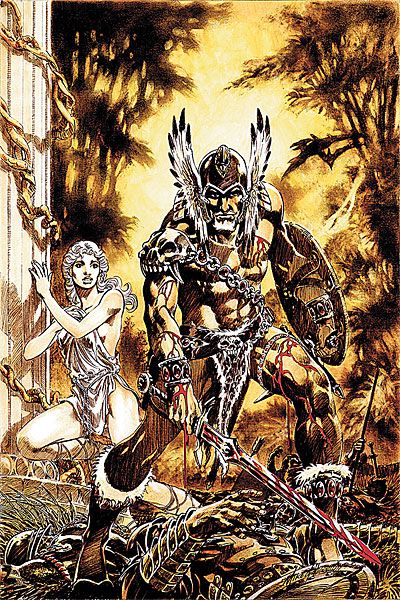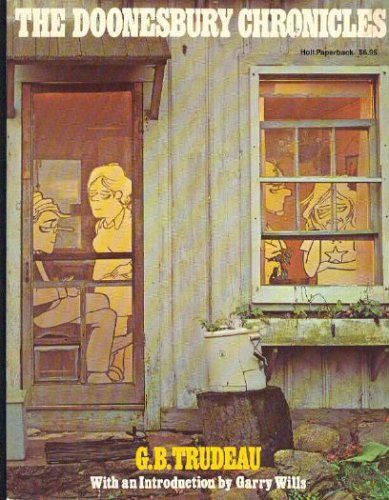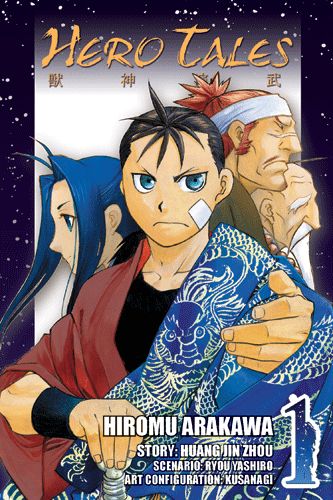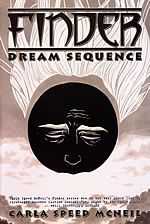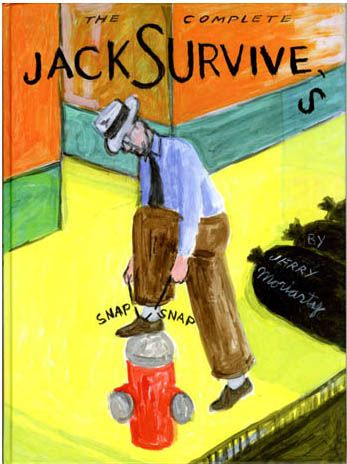Welcome to another edition of What Are You Reading. Pull up a chair and sit down, won't you? Our guest this week is Bill Kartalopoulos, who teaches classes about comics and illustration at Parsons, is a contributing editor for Print Magazine, and a comics reviewer for Publishers Weekly. But he's probably best known as the Programming Coordinator for the SPX convention in Bethesda, MD.
Bill and everyone else has quite a number of books by their bedside table this week, so we'll get right to it. Be a dear and click on the link below, won't you?
Tom Bondurant: Not really comics, but through the magic of Netflix I have been watching the "Middleman" TV show. After four episodes, it's pretty charming, although it feels like a very Kevin Smith-y kind of show. Since creator Javier Grillo-Marxuach was involved with this adaptation, I imagine it's fairly faithful to the comics, but I'm still tracking those down, so I can't compare.
A little further from comics (Howard Chaykin, Roy Thomas, and Marvel are mentioned briefly), I finally found time to read J.W. Rinzler's The Making Of Star Wars (2007). It's an exhaustive coffee-table-sized tome (with dictionary-sized print) which dug deep into the Lucasfilm archives to describe, in nerdgasmic detail, the origins of George Lucas's 1977 classic. The book is also thick with illustrations and other graphics, including periodic charts showing how each draft of the script crept closer to the final film. By the end I felt like I had been sleeping on a cot at ILM along with the other harried effects artists.
The book stops at December '77, and seems to draw largely from period interviews, so it doesn't get into the other movies or Lucas' subsequent revisions to this one. However -- and I don't think was intended specifically, but I'm sure no one at Lucasfilm minds -- it did give me a greater appreciation for Lucas wanting to revisit this movie. He put so much of himself into it, and was frustrated both by Fox and logistical limitations, that I can see where technological advances would make him want to "fix" things. Still doesn't explain wanting Greedo to shoot first, though.
At last with the comics, I was pleasantly surprised by The Warlord #7, written and drawn by creator Mike Grell. After the initial six-issue arc which reintroduced the residents of Skartaris and brought in a new group of 21st-century explorers, this issue finds Travis Morgan with amnesia (as "The Middleman" noted, the kind which only happens in comic books) and the new best friend of an unfamiliar damsel-in-distress. There's not much more to the story than that, but Grell tells it well, using double-page spreads both as spectacle and as an exposition substitute. Because there aren't half-a-dozen characters to manage, the issue has more breathing room, and Grell paces the fights and the conversations effectively. This is also the
best I've seen of Grell's artwork in a while -- usually I think his figures are a little off, but not so much here. I don't think he'll be on story and art for an extended period, but like Dave Gibbons writing and drawing Green Lantern Corps a few years back, it's nice to see him in familiar territory.
I've also started reading my TOTALLY FREE REVIEW COPY of Joe Daly's Red Monkey Double Happiness Book, which arrived on my doorstep in a little wicker basket with a note saying "Please give this book a good rev-- I mean, home," but which for whatever reason I had been neglecting. So far I've gotten through the relatively-short first story, "The Leaky Cello Case," and found it to be nice and laid-back, if a little talky. Our slacker hero Dave must deal not only with various personal crises -- creativity stifled at work, a flooded
apartment, a sudden breakup -- but with a mysterious and unfriendly new neighbor whose handlebar mustache reminded me of a SpongeBob villain. Naturally the guy's up to no good, so Dave and his opposable big toes must solve the mystery before Mustache takes him out. It's an amiable story, meandering through the details of Dave's life so that the eventual plot feels like an afterthought. However, Daly's
style is quite appealing, and his use of color really brings his panels to life. The establishing shots of Dave's Cape Town environs are especially beautiful, and since the second story looks like a road trip I'm eager to see more of Daly's vistas. Daly observes the nine-panel grid pretty strictly, but he gets a lot out of it -- not like Watchmen, mind you, but still good.
I liked Strange Tales #2 well enough, but the story which still sticks with me (with Jacob Chabot's Chia-Stache a close second) is Jhonen Vasquez's bittersweet tale of little Donnie and his MODOK costume. Oh, Donnie -- if only you knew how much MODOK loved you....
Finally, I thought Justice League: Cry For Justice #4 (written by James Robinson, drawn by Mauro Cascioli) was the least objectionable issue to date. This was mostly due to Green Arrow saying what many readers have been thinking for the past three months -- namely, "Why The Face?" -- and Shazam backing it up with, of all things, the Wisdom of Solomon. Oh, and having the Shade show up at the end didn't hurt either. Generally speaking, this is where I thought the story was headed, so (for now, at least) I am happy. Or, you know, less upset.
Michael May: I'm not too far into Al Williamson's Flash Gordon, but already I'm pleasantly surprised. Not only is it all of Williamson's Flash stuff, but there are some nicely researched text chapters that deal with his life and how important Alex Raymond's character became to it. And when they say that it's all of Williamson's Flash stuff, they're not kidding. There are even pictures of some Flash-themed wood carvings he made in summer camp. Oh, and the dimensions of the book are huge so that you can make out all the details in the art. It's a really beautiful book.
I'm also re-reading the original Agents of Atlas mini-series. It's the first time I've read it in its collected form with the original Golden Age stories in the back. I read the Golden Age stuff before digging back into the modern story and I'm glad I did. I understand why Marvel ordered the material like they did, but I wish that they'd put it all in chronological order. The old stuff informs Parker and Kirk's story a lot more than I thought it would. So much so, that even though Parker and Kirk fixed it so you don't have to have read them, I'm now curious about the Marvel Boy stories in Fantastic Four and Marvel: The Lost Generation. And I was pretty sure that nothing could make me interested in Marvel: The Lost Generation.
Tim O'Shea: Tom Spurgeon's post, On The Subject Of Return Reading, made me track down the collected 1970s editions of Doonesbury. At present I'm enjoying The Doonesbury Chronicles and totally agree with Tom's statement "I'm struck by how fantastic a character Joanie Caucus is." Looking at the abundance of characters that Trudeau created back then, I would love to see Trudeau revisit certain character dynamics. (For instance, you rarely see scenes between Joanie and her daughter JJ any more...)
In terms of comics, for juxtaposition I bought Planetary 27 and Astonishing X-Men 31 both written by Warren Ellis. The end of this series (or getting there) was clearly a struggle for Ellis, and no wonder. By his own admission, his own illness as well as the illness and death of his father (among many other factors) are wrapped up in his writing of the series' end. I wish I could compare Ellis' writing of two+ years ago with this new issue of X-Men, but it would be an oranges to apples comparison. Just by its nature, I loved getting the closure of Planetary 27. In terms of Astonishing X-Men, I'll be honest and admit I would not have bought it were it not for Phil Jimenez being the artist on the issue. That being said, Ellis' ability to juggle the banter of an old familar team in the midtst of chaos and adventure is what makes the issue (in combination with Jimenez's absolutely intoxicating pencils) a pleasure to read.
My Pal Carla(tm) has already thoroughly examined Doctor Voodoo's first issue. In comparison, my reaction is more simplistic. Even though I never read any of Bendis' Avengers, I'm curious to see someone other than Stephen Strange (admittedly drawn badly in this issue) try his hand at being the Sorcerer Supreme. Jefte Palo's art is a nice fit for the series -- and Rick Remender's hit-the-ground-running approach with the first issue ensures that I'll be back for issue 2.
Sweet Tooth 2 has some great fight scenes. I never thought I would write a sentence like that involving a Vertigo book or Jeff Lemire. Keep surprising me, Lemire. I like it.
Dark Reign -- The List: Secret Warriors one shot sports two fun things, Ed McGuinness' splash page homage to Steranko (the book also reprints Steranko's Today Earth Died! story) and the reveal of Nick Fury's personal list of "Save the world; Punch Norman (Osborn) in the face; and Have a beer". Jonathan Hickman is fast becoming one of my favorite Marvel writers. I see no reason why this was a standalone issue (other than the reprint) as this could have been included in the ongoing series (and when released in TPB, I'm sure that's how it will be handled). I understand that Marvel is in the business of making money,
but the frequency of one-shot offshoots from ongoing series is both annoying and nonsensical.
Grant Morrison's Batman and Robin is an interesting read for the sheer reason of seeing the character development he's pulling off with Robin. The more that Damian spends time away from his mother and grandfather, the more he's acting like a human being. It's nice to see the character evolve from the one-note "you annoy me and I want to kill you because I'm a psycho" demeanor he frequently sported.
I'm a huge fan of Jeff Parker's Agents of ATLAS (AoA), so I'm of two minds about this team-up with the X-Men. Hopefully it will get the legion of X-fans into wanting more AoA; but the other part of me gets overwhelmed by the sheer number of characters involved in the ever-growing X-family (Namor is an X-Men now?!? It just seems ridiculous that both Cloak and Namor apparently have to sport X's on their costumes, apparently so the other X-Men won't accidentally shoot them.) Also, I was slightly befuddled by the drastic shift in Jason Paz's inking style (it was like going from Byrne to Colan) with the two-page Venus kidnapped scene. That being said, Parker gives Ken more funny lines, so I'm happy. No really, it's the talking gorilla that's always sold me on this series. The back-up tale, Atomic Age Heroes (with the Silver Age incarnation of the teams), is the real delight for me, however. Chris Samnee's art style is the closest to a modern day Ditko (compliment)--yet more fluid in style than him--that I've ever seen.
BOOM's Irredeemable continues to pleasantly surprise me through the reveals that writer Mark Waid has built into the overall tale. And speaking of Waid, he convinced me to buy Power Girl 5 with his recent post about one page in particular.
For my day job, I do rudimentary graphic design. In an effort to boost my skill set, I picked up from the libary a copy of Debbie Millman's 2007 collection of interviews, How to Think Like A Great Graphic
Designer. It includes the following exchange with Chip Kidd:
"Do you regret anything?
"I regret not making the effort to meet Charles Schulz in his lifetime. I tried to make up for it by putting together a book that pays proper homage to his work (Peanuts: The Art of Charles M. Schulz). I think I was only partially successful."
Brigid Alverson: The Yen Press review copies arrived this week, and one that caught my eye right away was Hero Tales, a new series by Hiromu Arakawa, the creator of Fullmetal Alchemist. Actually, it’s by a bunch of people but Arakawa apparently did the art, and it’s very smooth. The story is your basic shonen martial arts tale of a young man with extraordinary powers who must prove himself; nothing new here, really. If you like lots and lots of fighting, with a few supernatural elements thrown in, then this is a good choice. (Actually, it’s wuxia, Chinese martial arts.) Arakawa has a clean, easy to read style, which makes this a pleasant book even for someone like me who is not a huge shonen fan.
I’m too friendly with the creators of Nightschool to do an objective review of it — I chat with Svet occasionally and the toner, Dee DuPuy, is a good friend of mine—but I’ll mention it here anyway. The story is still complicated, with several strands that haven’t quite come together yet, but it’s more fleshed-out than the first volume. Alex, the main character, seems to have a stronger voice in this volume. I love Svet’s art—like Arakawa’s, it’s clean and deceptively simple. She uses a few simple lines to sketch each character, but she chooses those lines well so that each character has a distinct personality.
One thing Yen Press does a lot of, and seems to do very well, is manhwa (Korean comics). They picked up Ice Kunion’s catalogue and have been publishing the books on beautiful paper with gorgeous covers. I wasn’t impressed with the first chapter of Sarasah when it ran in Yen Press — it’s about a girl who has a stalkerish obsession with a classmate, and at the end of the first chapter, she falls down a staircase and dies. When I picked it up again, though, I was charmed by the fact that she wound up in a heaven where the gods wear traditional robes but talk on cell phones. The story veers off into a past-life romance, which I think I can handle. Yen’s manhwa all has a similar look — it’s very stylized in the big-eyes-small-chin kind of way — and the drawings all seem rather hard-edged and flat. I’m not crazy about it, but if the story is good enough I can get past it. We’ll see.
Matt Maxwell: FINDER: DREAM SEQUENCE by Carla Speed McNeil
FINDER is a treasure in comics, and a rare one at that. In a medium that generally doesn't serve up science fiction (much less *good* science fiction), FINDER wholeheartedly embraces the best of what makes good science fiction good. There's both extrapolation and commentary on the current, but at the heart of it is how the technology affects (and even effects) the characters. But FINDER isn't fetishist in either hardcore cyberpunk tropes or galaxy-spanning storylines that are simply high fantasy in drag. It presents honest and tangibly real stories that could only (as the saying goes) be told within comics. I won't say that every page is exemplary of formalist wonder, but there are many pages that make you pause and consider what the medium can actually do, and how it can actually tell stories.
The story in DREAM SEQUENCE centers around Magri White, singularly gifted savant whose brain literally contains the most popular fiction/shared world in the world of FINDER. And that world is falling apart because Magri is falling apart. Weaving together a personal story as well as threads of the nature of creativity and the danger of self-loathing (particularly with regards to creative types, which is more destructive more often than you'd think), DREAM SEQUENCE is an outstanding example of why FINDER is among my very favorite comics. Sometimes it's a daunting read, because McNeil walks her characters and her own voice right out to the edge, but that's where the good stuff goes.
Sadly, I'll be all caught up on FINDER books soon. But that doesn't preclude re-reading (which is a rare thing amongst my comics reading these days.)
There's other stuff I read this week, but not much of it compares.
Bill Kartalopoulos: Here are some short takes on some (but by no means all) of the books I picked up at SPX, with a few others thrown in for good measure.
Map of My Heart by John Porcellino
I’m only just now dipping into this. I’ve read bits and pieces of John Porcellino’s King-Cat over the years, and am thrilled to have this nearly complete chunk of ten consecutive issues – covers, text pages, letter columns, and all – to read together as a partial record of this remarkable and hugely influential cartoonist’s life and art. John was an eloquent and inspiring guest at SPX, and I’m looking forward to spending a lot of time with this book.
The Complete Jack Survives by Jerry Moriarty
Another book I’ve only sampled so far, but the two-or-three-pages-at-a-time approach is appropriate here. Moriarty blots out the line between painting and cartooning – he calls himself a “paintoonist” – and Buenaventura Press’s definitive collection appropriately functions both as a lavish art book and as a readable collection of these profound and masterful painted comics and comics paintings.
Inkweed by Chris Wright
This has been out for a little while, but I was pleasantly surprised to see Chris Wright at SPX this year, and grateful when he gave me a copy of his book. This nicely designed short story collection makes a sustained case for Wright as a comics storyteller with a consistent point of view and a distinctive (and still mutating) visual style. His work has its own texture, and his stories resonate.
The Golden Age of Marvel Comics vols. 1 and 2
Among other recent influences, Paul Karasik’s Fletcher Hanks books and Greg Sadowski’s Supermen! have got me looking at – if not necessarily always reading – some early “Golden Age” comics, including early superhero comics. Lots of these are available online, but I prefer reading historical comics on paper when I can, and preferably in color. This kind of material has most often been reprinted in expensive hardcover editions for collectors (though DC has published several titles in its affordable, full-color, paperback Chronicles series). Marvel has just collected several issues of the publisher’s first title, Marvel Mystery Comics, as a $125 hardcover which I will never buy. Fortunately, I stumbled across these two portable, full color paperback anthologies from the late-90s. The first volume, edited by Roy Thomas, offers a court historian’s take on the company’s pre-Code period. The second volume is more specifically focused on the initial heyday of the superhero genre, and features many unknown characters alongside Carl Burgos’s pulpy, primary Human Torch, Bill Everett’s peculiarly misanthropic Sub-Mariner, and Simon and Kirby’s blockbuster Captain America. These books are out of print, but still findable at prices much lower than any currently in-print, deluxe collections of work from this period. FYI.
1-800-Mice #3 by Matthew Thurber
Matthew Thurber’s funny and inventive eco-social picaresque continues in this third, self-published issue (available for order via his website). With each issue, Thurber pursues his preposterous premises toward their illogical conclusions while drawing his expansive and expanding narrative ever more tightly together.
Ganges #3 by Kevin Huizenga
Huizenga uses cartoon language to diagram the fuzzy chaos of mental insomnia with absolute clarity and precision. He’s also really made the Ignatz format his own, with stunning use of limited color.
Pines #2 by Jason T. Miles
I was very excited to get a copy of Jason T. Miles’ latest, hot-off-the-press mini-comic at SPX. My quick browse raises expectations that the new one will be as innovative, mysterious and meaningful as the series’ first issue.
Windy Corner Magazine #3 by Austin English, ed.
This has been out for a few months, but I must put a plug in for my friend (and roommate) Austin English’s strong (yet somehow under the radar) magazine/anthology series. In addition to serving as a vehicle for Austin’s own current stories, Windy Corner features a variety of comics and drawings by other artists alongside thoughtful essays and interviews (this issue features Carol Tyler in conversation with Vanessa Davis; issue #2 boasts the definitive-for-now John Hankiewicz interview). As in the best anthology projects, the range of work suggests a distinct – but not constrained – aesthetic approach to visual narrative and picture making. These digest-sized, full-color, staple-bound issues convey a tactile intimacy consistent with the lush and graceful work on display.


